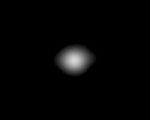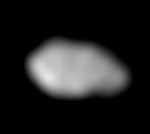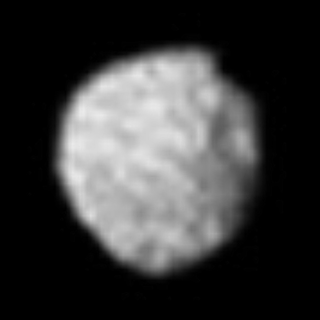
Adrastea, also known as Jupiter XV, is the second by distance, and the smallest of the four inner moons of Jupiter. It was discovered in photographs taken by Voyager 2 in 1979, making it the first natural satellite to be discovered from images taken by an interplanetary spacecraft, rather than through a telescope. It was officially named after the mythological Adrasteia, foster mother of the Greek god Zeus—the equivalent of the Roman god Jupiter.

Metis, also known as Jupiter XVI, is the innermost known moon of Jupiter. It was discovered in 1979 in images taken by Voyager 1, and was named in 1983 after the Titaness Metis, the first wife of Zeus and the mother of Athena. Additional observations made between early 1996 and September 2003 by the Galileo spacecraft allowed its surface to be imaged.

Amalthea is a moon of Jupiter. It has the third-closest orbit around Jupiter among known moons and was the fifth moon of Jupiter to be discovered, so it is also known as Jupiter V. It is also the fifth-largest moon of Jupiter, after the four Galilean moons. Edward Emerson Barnard discovered the moon on 9 September 1892 and named it after Amalthea of Greek mythology. It was the last natural satellite to be discovered by direct visual observation; all later moons were discovered by photographic or digital imaging.

Puck is the sixth-largest moon of Uranus. It was discovered in December 1985 by the Voyager 2 spacecraft. The name Puck follows the convention of naming Uranus's moons after characters from Shakespeare. The orbit of Puck lies between the rings of Uranus and the first of Uranus's large moons, Miranda. Puck is approximately spherical in shape and has diameter of about 162 km. It has a dark, heavily cratered surface, which shows spectral signs of water ice.
Pan is the largest crater on Jupiter's moon Amalthea. It is 89±4 kilometers across and at least 8 kilometers deep, with its center's coordinates being 30°N, 30°W. It is named after Pan, the Greek god of shepherds and the countryside, or the son of Amalthea and Hermes in some legends.

Thebe, also known as Jupiter XIV, is the fourth of Jupiter's moons by distance from the planet. It was discovered by Stephen P. Synnott in images from the Voyager 1 space probe taken on March 5, 1979, while making its flyby of Jupiter. In 1983, it was officially named after the mythological nymph Thebe.

Epimetheus is an inner satellite of Saturn. It is also known as Saturn XI. It is named after the mythological Epimetheus, brother of Prometheus.

Pandora is an inner satellite of Saturn. It was discovered in 1980 from photos taken by the Voyager 1 probe and was provisionally designated S/1980 S 26. In late 1985, it was officially named after Pandora from Greek mythology. It is also designated as Saturn XVII.

Eugene Merle Shoemaker was an American geologist. He co-discovered Comet Shoemaker–Levy 9 with his wife Carolyn S. Shoemaker and David H. Levy. This comet hit Jupiter in July 1994: the impact was televised around the world. Shoemaker also studied terrestrial craters, such as Barringer Meteor Crater in Arizona, and along with Edward Chao provided the first conclusive evidence of its origin as an impact crater. He was also the first director of the United States Geological Survey's Astrogeology Research Program.

Odysseus is the largest crater on Saturn's moon Tethys. It is 445 km across, more than 2/5 of the moon's diameter, and is one of the largest craters in the Solar System. It is situated in the western part of the leading hemisphere of the moon—the latitude and longitude of its center are 32.8°N and 128.9°W, respectively. It is named after the Greek hero Odysseus from Homer's the Iliad and the Odyssey. Odysseus was discovered by the Voyager 2 spacecraft on 1 September 1981 during its flyby of Saturn.

The rings of Jupiter are a system of faint planetary rings. The Jovian rings were the third ring system to be discovered in the Solar System, after those of Saturn and Uranus. The main ring was discovered in 1979 by the Voyager 1 space probe and the system was more thoroughly investigated in the 1990s by the Galileo orbiter. The main ring has also been observed by the Hubble Space Telescope and from Earth for several years. Ground-based observation of the rings requires the largest available telescopes.
Gaea is an impact crater on Amalthea, one of the small moons of Jupiter. It is 75 km wide and at least 10–20 km deep. Its center coordinates are -80°S, 90°W. One of two named craters on Amalthea, it is named after the Greek goddess Gaia.

Ida Facula is a bright mountain on Amalthea, one of Jupiter's smallest moons. It is known to be about 15 kilometers in width, somewhat smaller than the neighboring mountain Lyctos Facula. It was discovered by Voyager 1 in 1979 and in the same year named for Mount Ida, a mountain in Crete where Zeus played as a child. Firstly it was called simply Ida.

Prometheus is an active volcano on Jupiter's moon Io. It is located on Io's hemisphere facing away from Jupiter at 1.52°S 153.94°W.

Masubi is an active volcano on Jupiter's moon Io. It is located on Io's leading hemisphere at 49.6°S 56.18°W within a bright terrain region named Tarsus Regio. A volcanic plume has been observed at Masubi by various spacecraft starting with Voyager 1 in 1979, though it has not been persistent like similar Ionian volcanoes Amirani and Prometheus. Masubi is also notable for having one of the largest active lava flows on Io, with an additional 240 km (150 mi) flow forming between 1999 and 2007.

Tawhaki Patera is an active volcano on Jupiter's moon Io. It is located on Io's leading hemisphere at 3.32°N 76.18°W within the equatorial plains of western Media Regio. Tawhaki is an Ionian patera, a type of volcanic crater similar to a caldera, 49.8 kilometers (30.9 mi) wide and 550 meters (1,800 ft) deep.

Yangoor is the largest known impact crater on the surface of the Uranian moon Ariel. A central-peak impact crater, it is about 78 km in diameter and is located approximately 450 km from Ariel's south pole. The northwestern edge of the crater was erased by formation of ridged terrain. The crater lacks bright ejecta deposits and was imaged for the first time by the Voyager 2 spacecraft in January 1986. The crater is named after a spirit that brings day in Australian Aboriginal mythology. The name Yangoor was officially approved by the International Astronomical Union in 1988.

Several bright surface features were discovered on the dwarf planet Ceres by the Dawn spacecraft in 2015.

Occator is an impact crater located on Ceres, the largest object in the main asteroid belt that lies between the orbits of Mars and Jupiter, that contains "Spot 5", the brightest of the bright spots observed by the Dawn spacecraft. It was known as "Region A" in ground-based images taken by the W. M. Keck Observatory on Mauna Kea.

Zethus is a large crater on Jupiter's moon Thebe. The crater is named after Zethus, the husband of the nymph Thebe in Greek mythology, and is the only named surface feature on Thebe. It measures 40 km (25 mi) across in diameter, making quite large when compared to Thebe itself. Zethus, like many other craters on Thebe and Amalthea has bright spots located near its rim. Zethus never faces Jupiter due to being tidally locked to Jupiter in a way that Thebe's long axis points towards Jupiter.

















